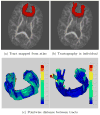Group analysis of DTI fiber tract statistics with application to neurodevelopment
- PMID: 19059345
- PMCID: PMC2727755
- DOI: 10.1016/j.neuroimage.2008.10.060
Group analysis of DTI fiber tract statistics with application to neurodevelopment
Abstract
Diffusion tensor imaging (DTI) provides a unique source of information about the underlying tissue structure of brain white matter in vivo including both the geometry of major fiber bundles as well as quantitative information about tissue properties represented by derived tensor measures. This paper presents a method for statistical comparison of fiber bundle diffusion properties between populations of diffusion tensor images. Unbiased diffeomorphic atlas building is used to compute a normalized coordinate system for populations of diffusion images. The diffeomorphic transformations between each subject and the atlas provide spatial normalization for the comparison of tract statistics. Diffusion properties, such as fractional anisotropy (FA) and tensor norm, along fiber tracts are modeled as multivariate functions of arc length. Hypothesis testing is performed non-parametrically using permutation testing based on the Hotelling T(2) statistic. The linear discriminant embedded in the T(2) metric provides an intuitive, localized interpretation of detected differences. The proposed methodology was tested on two clinical studies of neurodevelopment. In a study of 1 and 2 year old subjects, a significant increase in FA and a correlated decrease in Frobenius norm was found in several tracts. Significant differences in neonates were found in the splenium tract between controls and subjects with isolated mild ventriculomegaly (MVM) demonstrating the potential of this method for clinical studies.
Figures











References
-
- Alexander D, Pierpaoli C, Basser PJ, Gee J. Spatial transformations of diffusion tensor magnetic resonance images. Medical Imaging, IEEE Transactions on. 2001 Nov;20 (11):1131–1140. - PubMed
-
- Arsigny V, Fillard P, Pennec X, Ayache N. Log-Euclidean metrics for fast and simple calculus on diffusion tensors. Magnetic Resonance in Medicine. 2006;56 (2):411–421. - PubMed
-
- Barnea-Goraly N, Kwon H, Menon V, Eliez S, Lotspeich L, Reissa AL. White matter structure in autism: preliminary evidence from diffusion tensor imaging. Biological Psychiatry. 2004 Feb;55 (3):323–326. - PubMed
-
- Basser P, Pierpaoli C. Microstructural and physiological features of tissues elucidated by quantitative DT-MRI. Journal Magnetic Resonance. 1996 Jun;111 (3):209–219. - PubMed
-
- Basser PJ, Pajevic S, Pierpaoli C, Duda J, Aldroubi A. In Vivo Fiber Tractography Using DT-MRI Data. Magnetic Resonance in Medicine. 2000;44 (4):625–632. - PubMed
Publication types
MeSH terms
Grants and funding
LinkOut - more resources
Full Text Sources

